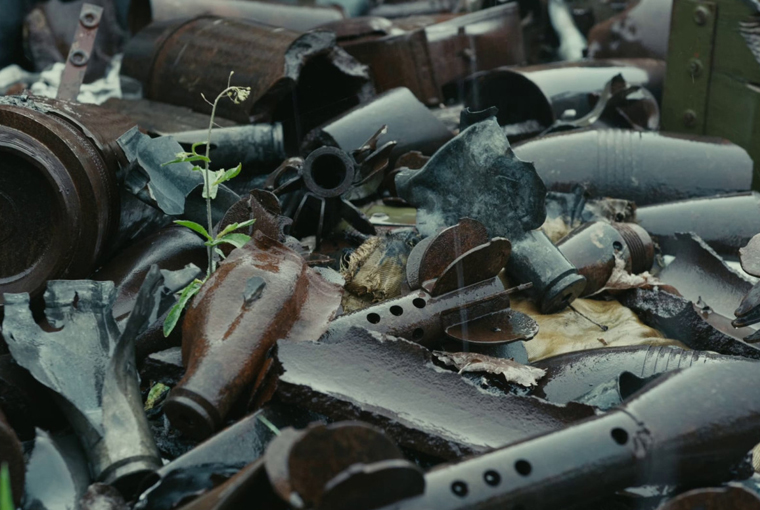
War is primarily a human tragedy, but we should not forget that nature typically suffers with us.” This is how the Ukrainian documentary film Divia, directed by Dmytro Hreshko, frames its purpose: to expose the ecological devastation caused by Russia’s invasion of Ukraine.1 The film opens with images that feel far removed from war – deer standing among pines, wild boars snuffling in the underbrush, horses moving through forest clearings, birds rising from the trees.
Much of the film is composed of drone footage and it takes a while before the first signs of war appear. The camera hovers over burned forests, fields covered with shell craters and, as it gradually moves closer to the ground, the same pastoral images return, now marked by violence. At first, the animals are shown to be alert, running away from the sound of bombings only for the boars and cows to end up rotting in minefields. The soundtrack, composed by Sam Slater, moves with similar dramatic crescendo. Known for his collaborations with Jóhann Jóhannsson and Hildur Guðnadóttir, Slater uses textured ambient layers and low-frequency pulses to shape a slow, hovering mood. Sparse tones enter at wide intervals – low drones, distant chords, and the occasional metallic echo. The inspiration is Godfrey Reggio and a style that invites philosophical meditation.
What we actually see, however, is at odds with what the film claims to show – that nature suffers with us. The animals die, the forests burn, but as much as Hreshko tries to write a requiem for nature, it doesn’t seem to grieve. Instead, grass grows back, birds return, and regrowth begins before the camera has left. In one scene, a plant grows out of the carcass of a fish, in another a bird rests on the canon of a tank.
Ecologists were among the first to note that the war in Ukraine, while certainly causing environmental disaster, also inadvertently benefits nature. Fred Pearce, writing for Yale e360 in an article titled “Ukraine Rewilding: Will Nature Be Allowed to Revive When War Ends?” reports that large parts of the Ukrainian countryside are undergoing spontaneous ecological recovery.2 With farming halted, roads abandoned, and villages evacuated, wildlife has returned to areas long shaped by intensive agriculture. Boars, wolves, and rare birds reappear. The risk, he writes, is that nature won’t be allowed to continue once the war ends and development resumes. A similar point is made by UWEC, a work group for the environmental consequences of the war. While the author of one article is careful not to celebrate abandonment, he acknowledges that “vegetation succession … is always an interesting process for a researcher” and that the suspension of farming has opened the possibility for the return of the Ukrainian steppe.3
This throws the film’s philosophical aesthetics into murky territory. Does war clear the way for ecological restoration? The idea has precedents. Pentti Linkola, the Finnish deep ecologist, for example, openly welcomes collapse as the only realistic check on environmental degradation.4 For him, modern civilization is more destructive than any war, and the only hope for nature is a sharp contraction of human systems.
This ambivalence surfaces most clearly in two elements the film neither problematizes nor frames: the drones and the music. Drones, of course, are tools of war. They are developed for surveillance and remote targeting. Hreshko makes no attempt to frame the drone as anything other than a meditative observer. The director may condemn destruction in words but filming it through the very instruments that sustain it may pose a problem of reflexivity. That is the film risks adopting the logic it means to expose. The music at times also adopts a form of theatrical pathos that makes it hard to tell whether we are witnessing the beauty of decay and renewal, or the tragedy of war. The slow, majestic observations certainly invite awe more than alarm.
The iconography of war in Ukrainian history honors sacrifice as a form of collective heroism (zhertovnyy podvyh). This concept appears in Cossack chronicles, where the warrior’s endurance and death in battle serve as a foundational narrative of national identity. Later, it surfaces in the remembrance of mass tragedies like the Holodomor and partisan resistance during World War II. By placing military violence and environmental collapse into a narrative of renewal and heroic endurance, Divia certainly follows a distinctly Ukrainian tradition. However, in asking us to admire sacrifice, it may risk recasting suffering as a means of rather than an obstacle to ecological recovery.
- Gogol Foundation. (n.d.). Divia. Retrieved July 13, 2025, from https://gogol.foundation/divia/index.html ↩︎
- Pearce, F. (2024, October 21). Ukraine rewilding: Will nature be allowed to revive when war ends? Yale Environment 360. https://e360.yale.edu/features/ukraine-war-wilding ↩︎
- Viter, S. (2025, April 23). The future of Ukraine’s abandoned agricultural land: Rewilding or a return to farming? Ukraine War Environmental Consequences Work Group. https://uwecworkgroup.info/the-future-of-ukraines-abandoned-agricultural-land-rewilding-or-a-return-to-farming/ ↩︎
- Amend, A. (2020, July 9). Blood and vanishing topsoil: American ecofascism past, present, and in the coming climate crisis. Political Research Associates. https://politicalresearch.org/2020/07/09/blood-and-vanishing-topsoil ↩︎




Leave a Comment